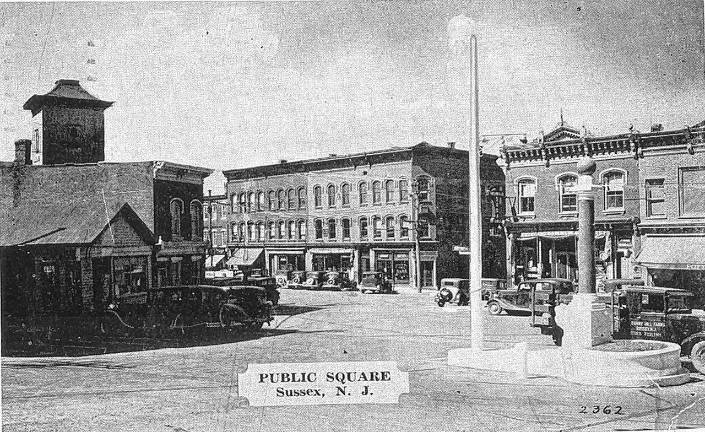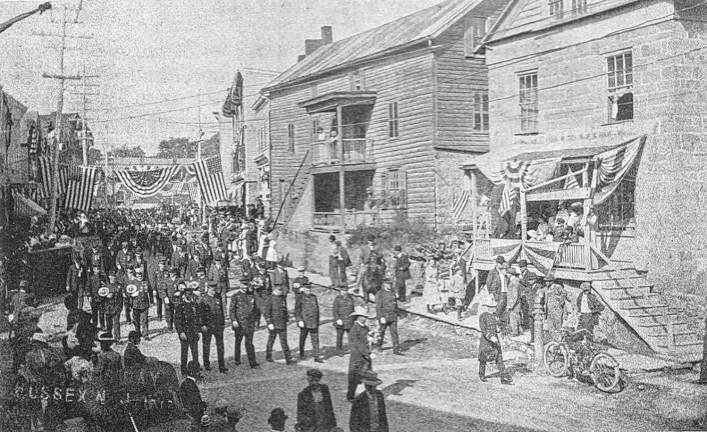

This column is by a guest historian, my friend from Sussex Borough, Mario Poggi, who is president of the Sussex-Wantage Historical Society.
As you walk along newly renovated Main Street on its new cement paver sidewalk, it is like taking a journey back in time.
Many buildings look the same as they did at the turn of the 20th century.
Before then, you had to climb quite a hill to enter Main Street from Hamburg Avenue. Horses had an extremely hard time trying to pull loaded carriages up the steep incline.
So the borough decided to lower it. It had been renamed Sussex from the old name of Deckertown on March 7, 1902, This is not a typo, Sussex Borough got its new name on March 7, not March 2, as is depicted in so much historic literature. That date later was certified at the request of the state in 1980.
About 1904-05, they lowered the roadway by hand by as much as six feet, starting at the Union House, where the incline began. Many of the buildings that once had ground-level entrances found that steps had to be installed to reach those same entrances and basement exposures appeared. Several of those lower levels eventually became the main entrances, such as at the Union House.
About that time, the bar was built at the Union House because it had a convenient entrance into it with the street lowering. Of course, today it is the Early American Tavern, having changed names after the Union House to the Sussex Inn.
This building began as a small grouping of stores in 1848 and expanded from there. Generations of local folks have enjoyed meals, celebrations and other events there. It also was a recruiting station during the Civil War.
As you walk along, the Old Stone Bakery stands out. Built in 1843 as a blacksmith shop, it later became a bakery, which had horse-drawn carriages deliver its baked goods around town. It too has a staircase leading to its front door, needed because of the street lowering.
Across the street is the VanSickle building, built by Dasen E. VanSickle before the street lowering. It too had many various businesses occupy it during its long history. It has undergone several renovations since and will house the future Sussex Saloon, going back to its original roots as a billiard hall.
Walking past a Sussex icon, Ratti’s News, which has been here for decades, the Cannon Block soon follows. It was built in 1872. The first floor held retail operations, such as a jewelry store, confectionary shop, pharmacy and an A&P. The upper two floors have apartments and the meeting rooms of the Samaritan Lodge No. 98.
The Samaritans have long since left but it has remained as intended with apartments in the higher floors and Bakers Pharmacy, and several different pharmacies before that, on the ground floor. The Samaritan Lodge No. 98 crest remains on the front of the building.
Across the street is the old opera house, or Hornbeck’s opera house. This is the Hornbeck block, constructed by Jacob E. Hornbeck in 1876. The top floor was a public meeting hall and could change quickly to an entertainment venue seating up to 800 and hosting operas, plays and eventually movies.
Chaplain Alanson Austin Haines GAR Post 116 met here as well, with Gen. Hugh Judson Kilpatrick as the commander. Today, it is the Norwescap Sussex Boro Community and Cultural Center. The first floor is the community center, which is also the home of the Sussex-Wantage Historical Society Museum and the two upper floors are apartments for senior citizens.
I invite you to visit our website at swhistoric.org, reach out to me by email at swhistoric@gmail.org, or call or text me at 973-864-7852.
Bill Truran, Sussex County’s historian, may be contacted at billt1425@gmail.com He is the author of “Honest Ogden.”